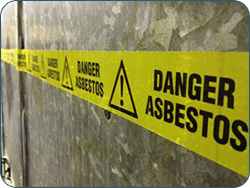 In the aftermath of torrential rain and flooding any clear-up operation carried out by any Company must be carefully planned out and accompanied by a risk Assessment if possible.
In the aftermath of torrential rain and flooding any clear-up operation carried out by any Company must be carefully planned out and accompanied by a risk Assessment if possible.
Understandably, businesses and landlords are keen to get back onto a normal footing as soon as possible. However, before refurbishment is carried out, steps must be taken to ensure that asbestos isn’t disturbed.
The inhalation of asbestos fibres can cause potentially fatal illnesses and is thought to be responsible for around 4,500 deaths every year.
The Law outlines that anyone responsible for maintenance and repair of a commercial or industrial property has a duty to identify asbestos in the premises and manage the risk.
Asbestos-related diseases kill more people than any other single work-related cause. All types of asbestos can be dangerous if disturbed. The danger arises when asbestos fibres become airborne. They form a very fine dust. Breathing asbestos dust can cause serious damage to the lungs and cause cancer.
Where in the House Might I See it?
Asbestos materials can be found in roof and floor tiles, bath panels, gutters and drainage pipes, airing cupboard walls, garage and shed roofs, fuse boxes and is more commonly associated with being used to lag pipes and to provide insulation to storage heaters but, in all its forms, it is not always visible to the naked eye.
Traditionally used in buildings for its properties of thermal and electrical insulation and high tensile strength, fears over the health risks associated with asbestos led to its use being banned within the UK at the end of 1999.
The most common high risk categories to watch out for are insulating board (AIB), lagging and sprayed coatings. Lagging was used for insulation of pipes and boilers widely in the 60s and 70s. Cement products were used in many buildings and while usually the danger is caused by drilling into asbestos or otherwise disturbing the fibres, the floods may already have done that.
Before you commission or do any construction work that is likely to disturb asbestos, you will need to find out if there are any asbestos-containing materials (ACMs) in the premises or structure.
- The amount of asbestos
- Where it is and what condition it is in
- Whether work is likely to disturb the material; and
- Whether and how the material needs to be safely protected or removed.
For demolition and refurbishment work, it is essential to find out, either from checking existing records (such as the client’s survey, asbestos plan or register) or commissioning a suitable survey before any construction work starts. It is good practice to include the need to survey asbestos and protect or remove it in the initial project cost and programme.
Licensed work with asbestos
Work with high-risk asbestos products, such as asbestos insulating board, sprayed fire or insulation coatings or lagging, must only be carried out by an asbestos licence holder who works within the conditions of their licence.
Other work with asbestos
For work with lower-risk asbestos products, such as decorative ceiling coatings and corrugated asbestos cement sheets, make sure that workers are properly protected and that you minimise the spread of debris – public fear and bad publicity are all too common, and decontamination costs can be huge.
Instruction and training
It is a legal requirement that your workers are trained to know about the health risks associated with asbestos, how to spot it, and what to do if they uncover damaged asbestos.
The duty to manage asbestos in buildings guidance from the HSE
